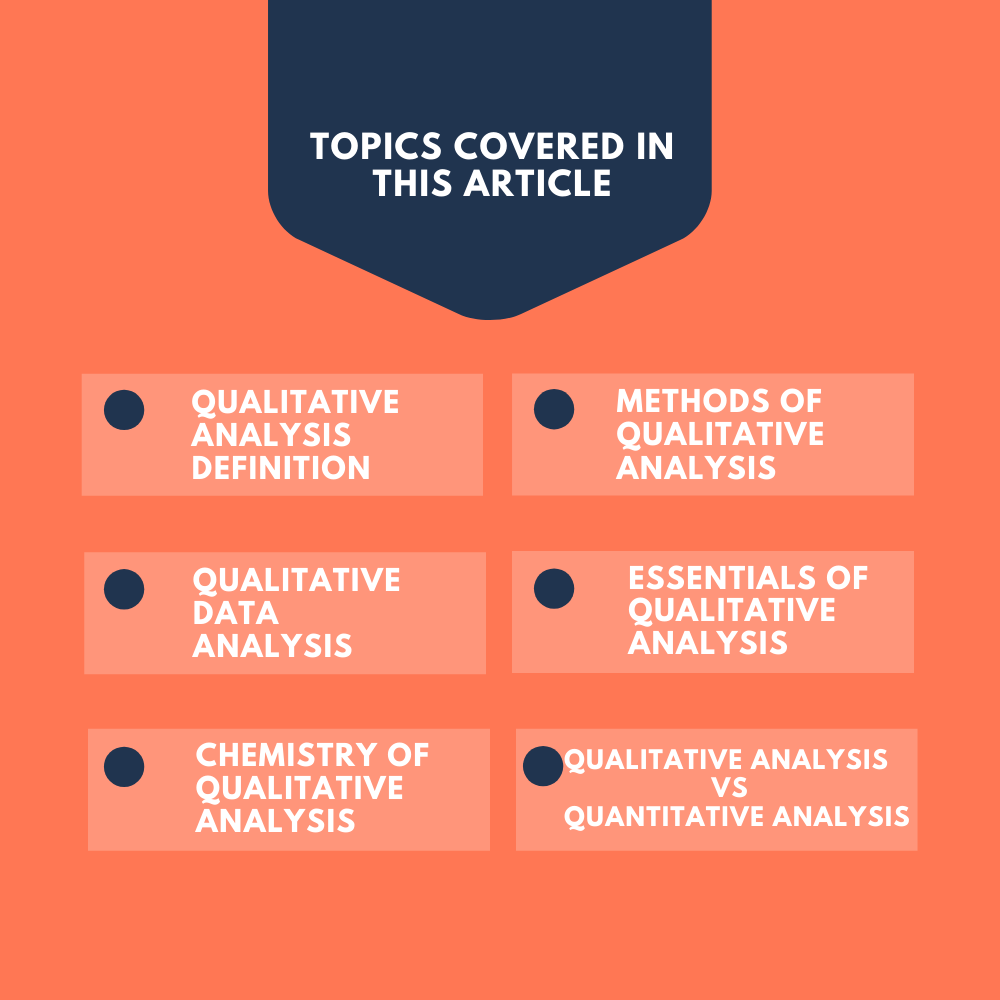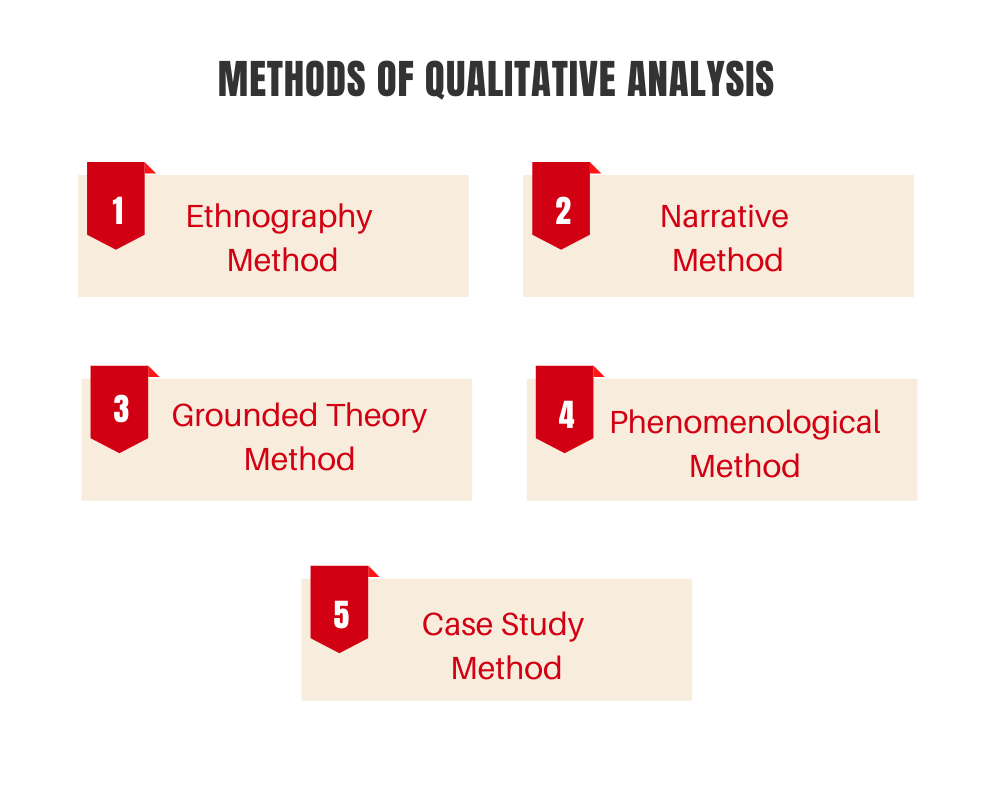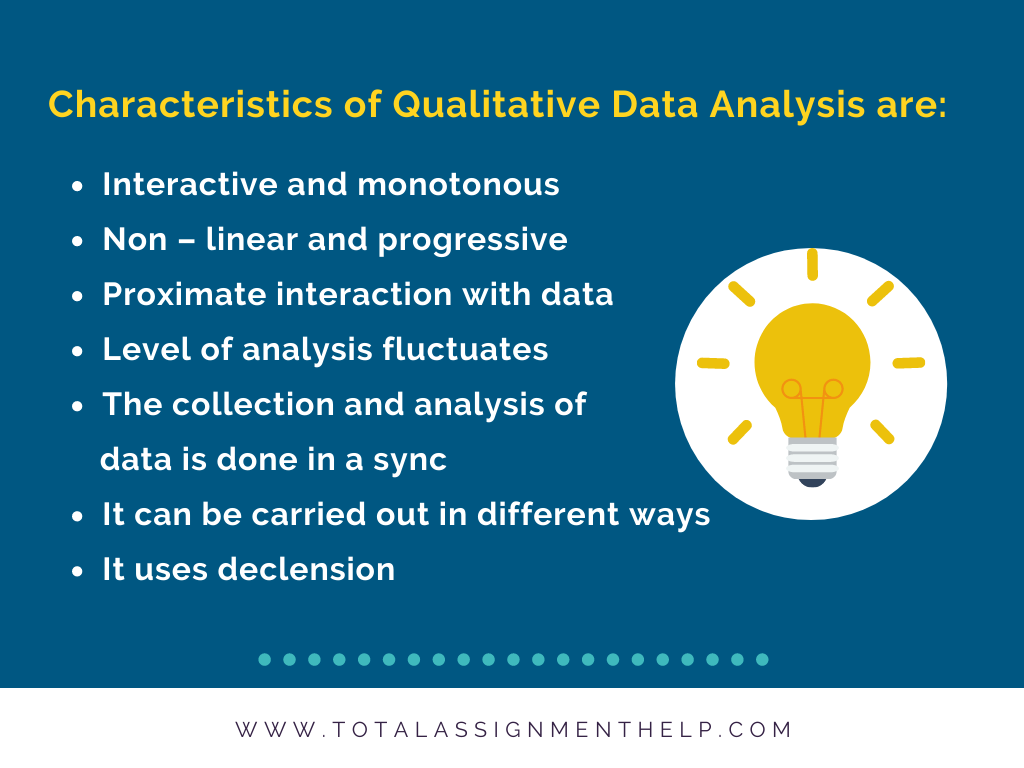Qualitative analysis refers to the analysis of the intangible factors of an organization. The factors do not talk specifically about the numbers of any operations of the organization but are equally important as any of the scales/numbers. The qualitative analysis focuses on examining non- measurable statistics, for instance, goodwill of the company, reputation of the brand, customer’s satisfaction, etc. By using personal judgment drawn from the uncountable information, a certain analysis is being done like the strength of research and development, expertise in management etc.
In usual practice, qualitative analysis is being used along with quantitative analysis to examine the operational system of the company, in order to evaluate the real potential from the investment aspect. In this article, qualitative analysis vs. quantitative analysis is also being discussed to have a better understanding.
This article focuses on the below – mentioned topics:
- Qualitative analysis definition
- Methods of qualitative analysis
- Qualitative data analysis
- Essentials of qualitative analysis
- Chemistry of qualitative analysis
- Qualitative analysis vs. quantitative analysis
Read on to know some intense informative facts on qualitative analysis.
Qualitative Analysis Definition
The qualitative analysis concentrates on examining the imprecise and intangible aspects related to experimental and social sphere over mathematical concrete calculations. This approach covers the crucial part that cannot be covered by the machines. Through this approach, one can analyze the factors that are almost impossible to calculate in numbers like the brand value of the organization, customer satisfaction, goodwill in the market, etc.
The purpose of conducting qualitative analysis is to keep a track on the inputs received to improve the productivity of the organization. Customers play a very crucial and vital role in the growth and success path of any organization, as the revenue earned by the company comes from customers only.
The significant components of qualitative analysis of an organization are its competitive advantage and business model. There is a set of questions that a company has to confront with, while, carrying out qualitative analysis. In specific, these questions can be listed as below:
- What is that one factor or thing that can win company the edge over its competitors and by keeping it ahead of them?
- Does the company have an exclusive policy or method to address the concerns of its customers?
- Is the company, globally recognized as a brand?
- Does the company have invented anything that cannot be replaced or imitated easily?
- Does company’s product have any unique quality that is attractive?
- Does the company have sustainability until next 20 years?
To define qualitative analysis – it is being conducted to study and understand all the related aspects based on the results of a quantitative analysis to affirm the growth of the company. Context has to be the main key factor in any qualitative analysis, as it is always based on facts.
Methods of qualitative analysis
The technique used for data gathering to carry out qualitative analysis, encompasses observation, interviews, and other methods that are similar to the methodology used in quantitative analysis. As qualitative analysis also uses the technique that comprises of personal interviews, observation, review of texts, etc. The purpose of study determines which method to opt.
The significant methods of qualitative analysis are mentioned below:
- Ethnography – it is one of the used and popular types of method that is being used by the professionals to conduct a qualitative analysis. In this method, the main focus is laid on the environment of target participants. This helps in understanding their aims, challenges, cultures, and sources of motivation.
Ethnography deals in cultural anthropology as well. In this method, while conducting the study, the professionals, look deeply into the culture to have a better understanding of it. During conducting any research, the person depends on the interviews and surveys conducted.
Ethnography deals in cultural anthropology as well. In this method, while conducting the study, the professionals, look deeply into the culture to have a better understanding of it. During conducting any research, the person depends on the interviews and surveys conducted.
- Narrative – this approach moves around a sequence of events, usually it moves from one to two persons in order to create a combined story. To carry out this method you need to conduct concise interviews, check out themes, study documents, etc. You must also make conscious efforts to know about the creator of a successful story.
It is not mandatory to arrange all the things in particular sequence, rather you can develop a story that can be narrative. In that, you can underline the stressful situations and challenges that contributed to the success story. Such highlighting points may provide the scope for a new invention or innovation.
The narrative approach is always a helpful method to create a character. In addition, if you can acknowledge a matching personality and interview the person, then it will help you in getting maximum information regarding the culture of the area.
- Grounded theory – this theory deals with providing an explanation or the concept of an event. In this method, you create a theory that is based on the collected data from initial interviews and available documents.
To find out themes, you may have to take help of many techniques and series that deals with axial coding. It is very important to go through a number of samples from 20 to 60 so that as per them, you can develop a strong theory.
This theory helps you in having a better understanding of the current users’ community, the particular use of the product or the success of the performed tasks.
- Phenomenological – it is considered as an appropriate method to carry out qualitative analysis. It is one of the most efficient methods to describe any event or activity. In this study, a number of methods are used to understand it properly that is being under examination. These methods include carrying out interviews, reading documents, watching videos, etc. To get the proper insight into the motivation of the participant, the main reliance is on the perspective of the participant.
To start with, this process, you do not need to determine a hypothesis. In this method, you need to conduct a number of interviews like from 5 to 25 under alike themes. This assists with emerging themes and validating the findings.
- Case study – this method assists us in having in-depth and comprehensive understanding through a vast variety of data sources. In research, case studies are categorized into three types, viz. descriptive, explanatory, and exploratory. Through a case study, all the relevant information related to your subject is provided, afterward, you can study it extensively.
Qualitative Data Analysis (QDA)
Qualitative data analysis engages a range of procedures and processes, in which you move from the collected qualitative data into an explanation, understanding of people and circumstances you are examining. The data is collected in the way to get the accurate interpretation, understanding, or clarification of the situation and people on which the study is being conducted.
The concept of qualitative analysis is established on the philosophy of interpretation. The main aim of qualitative data is to study significant and figurative substance.
Principles of QDA
The principles of QDA are mentioned below:
- Every individual is different, hence, understands and experiences every reality differently.
- The aim of qualitative analysis is to create a theory or illustrate any incident on the basis of data.
- A justified explanation of social events can only be understood in terms of its context.
- It is almost impossible to explain any social occurrence by keeping its context separate.
- There are always some exceptional cases, which provide insights into an issue. At times, the study assists in developing new ideas that help in the further investigation.
- Human behavior is complex, hence, not that easy to interpret or understand. The capability of understanding human behavior comes gradually.
Characteristics of QDA
The characteristics of Qualitative Data Analysis are as follows:
- Interactive and monotonous
- Non – linear and progressive
- Proximate interaction with data
- Level of analysis fluctuates
- The collection and analysis of data is done in a sync
- It can be carried out in different ways
- It uses declension, i.e. pointing something in specific like, ‘it is good’.
Prominent focus areas while analyzing a data
- Firstly, you must read the content of the primary message.
- Secondly, analyze the context and attitude of the speaker with respect to the message.
- It is important to analyze that if the communicated message signifies the ideas of an individual or a group.
- Always analyze the intensity in which the speaker communicates his actual vs supposed experience.
Approaches used while conducting qualitative data analysis
- Inductive Approach –
- Qualitative research is the major contributor to any investigation, then this approach is used.
- It is also used when developing a framework for a group and then other factors.
- Deductive Approach –
- It is used to frame research questions in order to sequence the data and afterward looking for similarities and dissimilarities.
- It is used when there is a scarcity of time and resources.
- It is used when qualitative research is a small helping aid in a larger quantitative research.
Essentials of qualitative analysis
Qualitative analysis requires much time in comparison with quantitative analysis. It is about trusting your instincts with keeping your focus on the facts. The most critical factor is what employees feel about their organization and the management? Are the employees satisfied or dissatisfied?
Such questions clarify various vital factors about the company, for instance, workplace culture of the company, employees loyalty towards their company, etc. You must try to become the person, who can develop a rapport with people easily so that they can talk comfortably and more openly. All these key elements are directly related to qualitative analysis.
Qualitative analysis
assists in developing a plan in order to have better styles of communication and improvising the strategies of the company. Two key factors that can contribute well to the growth and success of any organization are properly formulated practical strategies and clear communication channel. All of these elements play an essential role in carrying out a successful qualitative analysis.
Chemistry of Qualitative Analysis
To define qualitative analysis in terms of chemistry, it deals with determining the composition of the chemical of the given sample. It comprises a set of procedure that gives the information about any specimen, which is not – numerical.
The qualitative analysis provides the valuable information regarding the presence or absence of an atom, functional group, ion or compound in the sample. However, evaluation in terms of quantity is not possible. Quantitative analysis is used to calculate the quantity.
Quality analysis – Branches – Chemistry
Qualitative analysis is divided into two major branches, i.e. Organic Qualitative analysis and Inorganic Qualitative analysis.
The organic qualitative analysis is about various types of functional groups, molecules, and chemical bonds. The organic qualitative analysis concentrates on the iconic and elemental composition of the sample by the means of examination of the ions in an aqueous solution.
Tests & Techniques
Kastle – Meyer test is one of the most popular qualitative chemical tests. It is performed for blood and afterward, Iodine is tested for starch. The flame test is another popular test, which is being used in the inorganic chemical testing.
The qualitative analysis determines all the changes that take place in the smell, color, boiling point, reactivity, melting point, precipitation, bubble production and radioactivity. The methods comprise distillation, precipitation, extraction, spectroscopy, and chromatography.
Qualitative Analysis Vs. Quantitative Analysis
The significant comparison points of the two are discussed below:
| Qualitative | Quantitative | |
| Conceptual | The focus is on attaining a better understanding of human behavior from the point of view of the source. | The focus is on searching the facts regarding the social circumstances. |
| In this, a vast and negotiable reality is being assumed. | In this, a fixed and measurable reality is being assumed. | |
| Methodological | The data can be collected from interviews and observations. | The data can be collected by computing things. |
| The analysis of data is being done by the description of themes given by informants. | The comparison of statistical inferences and numerical data are used to get the data. | |
| The data is recorded after going through an appropriate statistical analysis. | The data is recorded exactly in the language it is being received from the informing person. |
Conclusion
The above – mentioned information has covered most of the significant aspects related to qualitative analysis. The students studying Qualitative analysis often struggle with writing its assignments, as it requires deep study and intense knowledge. The topic is very critical and crucial for the students; often they seek assistance in their assignments. Considering the sensitivity of the topic, students must choose the assignment writing service provider very carefully. It is always best to refer to the feedback and testimonials to know the satisfaction amongst the customers. Total Assignment Help is well – acknowledged in the industry, as the students repeat hiring their services. For any type of query, you may contact Total Assignment Help, at any hour of the day. Our customer care support service is available to assist you 24 X 7. We are the most committed and trusted brand in the industry. You may also visit our website to know more about the services offered.
Wish you a great luck!







